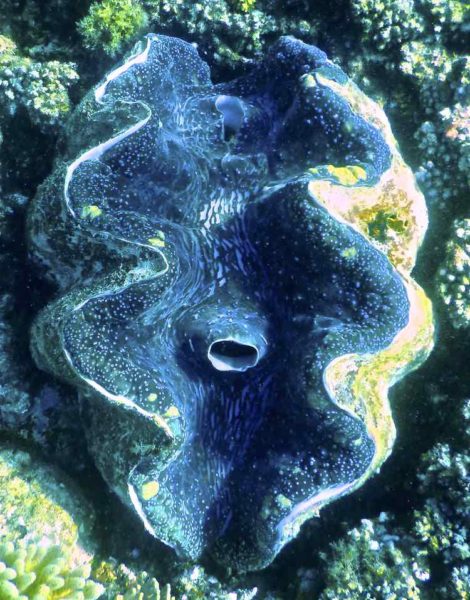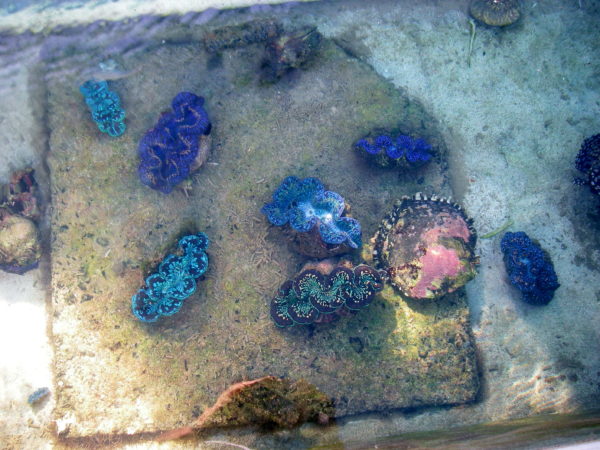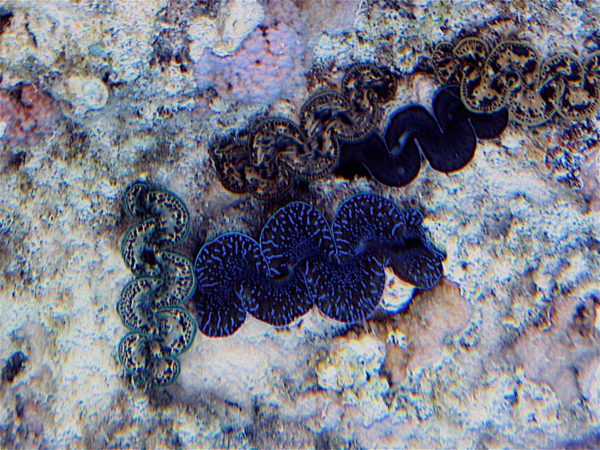Published in the Ocean Watch column, Honolulu Star-Advertiser © Susan Scott
October 21, 2017
ORPHEUS ISLAND, AUSTRALIA >> After nearly a week of snorkeling on the outer reefs of the Great Barrier Reef Marine Park, stormy weather forced Craig and I to sail our 37-foot boat, Honu, back to the shelter of this island. Although Orpheus is also a national park with its own charming beaches, birds and reefs, we missed our giant clams.
While anchored on the reef, we had discovered a several-acre area that looked like the site of a mermaid’s banquet. Table after table was set with pink, green and lavender plate corals sitting between runners of gold and tan leather corals. In the midst of these place settings sat dazzling centerpieces: blue, green and gold giant clams.
 A giant clam sits on a bed of coral in Britomart Reef in Queensland, Australia.
A giant clam sits on a bed of coral in Britomart Reef in Queensland, Australia.
©2017 Susan Scott
A major downfall of these beautiful bivalves is that they’re sitting ducks, big pieces of meat that can’t run away and have only minimal defense. (They can close their shells somewhat but don’t slam shut like they do in cartoons.) Because the colorful algae in their soft tissues need sunlight to thrive, the clams grow mostly in clear, shallow water, making them easy to find, kill and eat.
Like stony corals, giant clams host algae in their tissues that grow sugars for the clams. If conditions are prime and the algae get too dense, the clam simply eats them, too.
A giant clam gathers fertilizer for its algae directly from the seawater that bathes it. Covering the soft, gaping lips of the creature is a type of tissue that can absorb ammonia, nitrate and phosphates, nutrients crucial for plant growth.
The clam breathes, and gets nutritional supplements, by inhaling water through a round siphon on one end of its soft body and sifting out tiny plants, animals and oxygen. The filtered water exits out another siphon on the clam’s opposite end.
Because giant clams grow well in tanks, aqua-farmers in Palau, the Philippines, the Cook Islands and other areas grow them for food, for the aquarium trade and to replenish reefs where people have overharvested.
 Giant Clams being grown in a tank in the Cook Islands.
Giant Clams being grown in a tank in the Cook Islands.
©2006 Scott R. Davis
Just when Craig and I were reminiscing about our amazing experience in what we named the Super Duper Royal Clam Garden, we made a joyful discovery. Near the James Cook University’s marine science center in Orpheus Island’s Pioneer Bay, researchers had planted a giant clam garden in the 1970s.
We found the man-made plot by accident while going ashore in our dinghy. From the surface we could see the 3-foot-long creatures smiling up at the sun, their oval bodies resembling iridescent place mats, and their siphons projecting from the flesh like white porcelain cups. Today 40 to 50 (my guess) mature clams thrive there.
Swank dinner parties aren’t Craig’s and my usual thing, but last week we attended two and we didn’t get a bite to eat. In giant-clam gardens the feast is for the eyes.
 Colorful Giant Clams-Bora Bora, French Polynesia.
Colorful Giant Clams-Bora Bora, French Polynesia.
©2006 Scott R. Davis